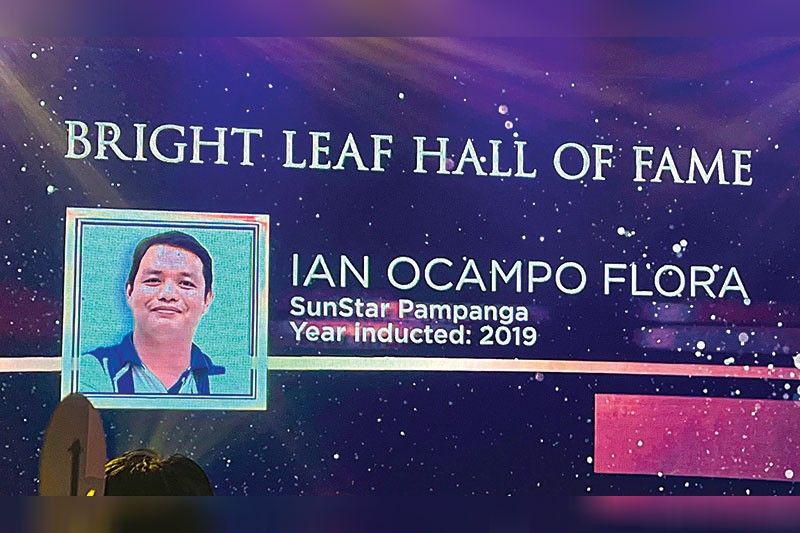A dynamic group of journalists


It was my seventh straight year to serve as chair of the board of judges for the 17th Brightleaf Agriculture Journalism Awards. No way I could decline attendance last Nov. 14 at the awards ceremony at the Fairmont Hotel ballroom, despite usually avoiding any social events as I continued to build up my health after getting confined at the Medical City for a week last September, and subsequent status as an outpatient at home.
I had joined as a judge over a decade ago, before being elevated to the chairmanship. So I knew the kind of passion that had driven PMFTC, Inc. head honcho Dave Gomez to keep the awards process thriving as his “baby.” It had to skip a year, as he reminded everyone. So actually, its 18 years meant that the Brightleaf Awards had turned into a debutante this year.
The judges went through pre-screened entries covering ten categories. Recent years saw additional genres involving TV, radio and digital broadcasting categories, making it a tougher responsibility for the judges.
The distinguished list included Kristine Bersamina, managing editor, Philstar Global Corp.; Ralph Galan, assistant director of the UST Center of Creative Writing and Literary Studies, as well as a published poet and translator; Jimmy Domingo, photography and photojournalism lecturer at UP Diliman and De La Salle University; J. Albert Gamboa, vice chairman of the FINEX Ethics Committee, and finance columnist for BusinessMirror, Manila Times, Manila Bulletin and Pilipino Mirror; Corrie Narisma, managing editor of InsiderPH.com; Edwin Sallan, digital content manager and section editor of BMPlus, SoundStrip and tourism at BusinessMirror; Yvette Tan, agriculture columnist for Manila Bulletin and fiction author of horror stories; Rem Zamora, photo editor for the Philippine Daily Inquirer and photography professional lecturer at De La Salle University; and Dr. Marby Villaceran, director of the UP Center for Women's and Gender Studies and a faculty member of the UP Department of English and Comparative Literature.
As chair of judges, I had to deliver a brief speech, acknowledging that we had been treated to a most dynamic and diverse group of winners. Out of over 300 qualified entries, each submission challenged us and highlighted the importance of the voices involved in the agricultural narrative nation-wide. Indeed, it was refreshing to see both industry stalwarts and brand-new names join the following winners’ list.
Agriculture Story of the Year: “Magtanim ay di biro” of I-Witness, GMA Network Inc.;
Best Agriculture TV Program or Segment: “Bagsik ng harabas” by Ian Carlos Simbulan,
GMA Network Inc.; Best Agriculture Radio Program or Segment: “Hanip, harabas, El Niño phenomenon: Mga hamon sa pagbangon” by Zhander Cayabyab, DZXL NEWS 558 KHZ – RMN Manila; Best Agriculture News Story – National: “Baguio, loving flies, but the good kind” by Marilou Guieb, BusinessMirror; Best Agriculture News Story – Regional: “Sugar ‘smuggling’ hurts both farmers, consumers” by Earl Kim Padronia, Sunstar Cebu; Best Agriculture Feature Story – National: “From arms to farms” by Richel V. Umel & Ryan Rosauro, PDI; Best Agriculture Feature Story – Regional: “Government worker’s research helps ‘ulang’ industry in CL” by Ian Ocampo Flora, Sunstar Pampanga; Best Online Story: “Scientists probe climate change’s role in new pest infestation in PH rice fields” by Joshua Mendoza, Climate Tracker Asia; Best Story in Tobacco Product Alternatives: “From plant to pet: Tobacco leaf extract leads way in new veterinary products” by Ian Ocampo Flora, Sunstar Pampanga; Tobacco Photo of the Year: “Masaganang ani” by Jonathan (Jonas) Sulit, Abante; and Agriculture Photo of the Year: “Sustainable fibers” by Jose Revoli Cortez, Manila Standard.
Our agri journalists constantly offer fascinating stories that pique interest and provide fresh knowledge, often much to our surprise. Such is the case with Guieb’s “Baguio, loving flies, but the good kind.”
“(Baguio City Mayor) Magalong is a big believer in the concept of circular economy, or the practice of turning waste into resource.
“Days after Magalong had announced giving up the WTE (waste-to-energy technology) project, Rolando James Bayang, more popularly known as Doc Brahman, approached the mayor with the proposal to replicate a solid waste management (SWM) system with the use of black soldier flies (BSF) he is successfully running in Pampanga.
“Baguio, the summer capital, becoming a breeding ground for flies and earning the title of ‘city of flies’? Understandably, the visual and the thought are repulsive. According to Doc Brahman, this is one reason why people and local governments are hesitant to adopt it, fearing it may lead to a pest problem.
“To demonstrate the system, Doc Brahman started one setup at the dumpsite in Irisan barangay in Baguio, financing it on his own…
“The BSF breeding station in Pampanga clearly shows the life cycle of the BSF. The place where the flies mate must be kept clean and not so hot. Unlike houseflies, the BSF has a life span of only nine or ten days and their only mission in being is to propagate. Once they mate the male BSF dies. Two days after mating, the female lays its 500 to 900 eggs and dies after.
“The eggs are harvested and very carefully nurtured in a nursery until they hatch after four days. At the larvae stage, all they do is eat and they can eat as much as ten times their weight.
“Black soldier flies are saprophytes, meaning they feed only on decaying, rotten, or dead organic matter. People often cringe when houseflies land on their food, fearing where they may have been. However, BSF larvae will not consume clean food. As adults, due to their short lifespan and the urgent task of mating and reproducing, they do not eat at all. After about two weeks, their brown droppings are sifted, dried and used as fertilizers.
“… So BSFs solve trash problems, are good fertilizers and are used for animal feeds, asserted Doc Brahman, whose dream is to have a BSF facility in every town.
“… Recently Fred Fangonon presented to the city council a revival of his aerobic crib technology, a system that earned him recognition as an outstanding citizen when he first introduced it while serving as the barangay captain of Loakan.
“He proposed to the council the massive crib composting technology. It involves large amounts of biowaste to be systematically distributed in cribs that allow air to compost the pile. It will also be aided by earthworms, microbes and, yes, BSF larvae. …
“He assured that BSFs will not become a pest due to their short lifespan. They do not approach kitchen food, as the larvae feed exclusively on smelly rotten material, which they convert into high-protein, calcium-rich fertilizers and animal feed. …
“His dream is to compost all the biowaste of the city. …
“Indeed, the city may soon be not just the City of Pines but also a City of Flies, the good kind.”
Apart from enviable cash prizes and laptops, some of the top winners are treated to a holiday in a SouthEast Asian city. In February, it will be Bangkok. Repeat winners join the Hall of Fame as Oriental Leaf awardees after winning five times. They can try to repeat the cycle after a break of three years. This year, earning the Oriental Leaf awards is Ian Ocampo Flora, making it nine Hall of Famers thus far.



















